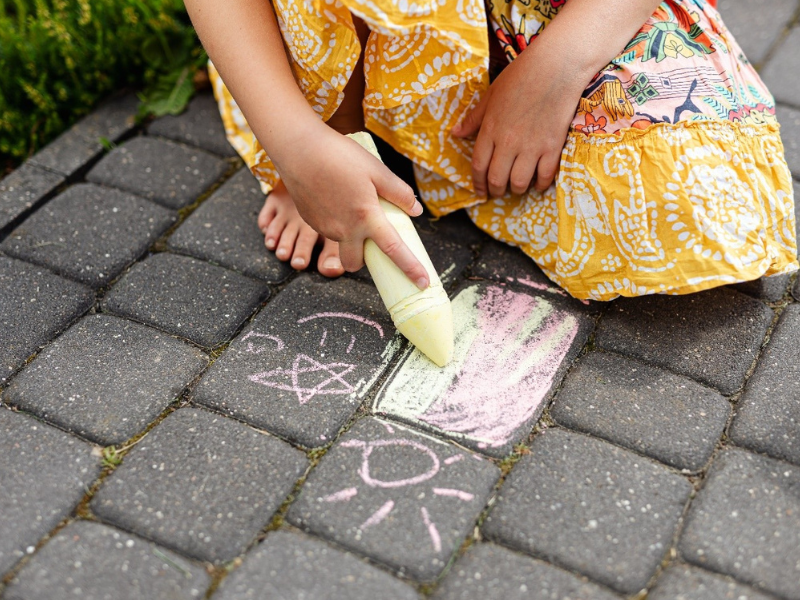
Sidewalk chalks, like other consumer products, can contain inadvertent PCBs. These toxic chemicals enter the environment as they're washed away or disposed of.
Every day, people use products that contain toxic chemicals. Sometimes, a product is intentionally toxic – like bleach or a pesticide. Other times, a chemical is used as an ingredient without a full understanding of how it will affect the environment and people’s health.
That’s the story of polychlorinated biphenyls – better known as PCBs.
For decades, PCBs were widely used in a huge range of products. And those products were used in homes, offices, manufacturing – even in roadways and sidewalks. Decades later, research began to reveal the serious threat these chemicals pose to human and environmental health.
Today – decades after they were banned nearly everywhere – PCBs continue to make their way into bodies, homes and the environment. These PCBs are present as a by-product or side effect of a manufacturing process. Under federal guidelines, a certain amount of these inadvertent PCBs are allowed in products, which have been found to directly expose people and contribute to PCB contamination in the environment.
What are we doing to address PCBs in products?
This month, we petitioned the Environmental Protection Agency (EPA) to initiate rulemaking to protect public health against PCBs in consumer products. Currently, some inadvertent PCBs are allowed in consumer goods. We’d like to work with state and tribal governments to establish new, lower federal limits on allowable inadvertent PCBs in consumer products. In our petition, we suggest an eventual limit of zero, phased in over a 10-year period, along with identification of applicable test methods.
Last year, we released guidance for managing building materials with PCBs. Prior to a ban in production in 1979, PCBs were used in electrical transformers and capacitors, but also as plasticizers, wax and pesticide extenders, and lubricants. Additionally, building materials such as caulks, sealants, and paints contained PCBs at high levels. We want to reduce pollution from PCBs in building materials by promoting best practices before and during demolition or renovation, when PCBs are more likely to be released into the environment.
Our light ballast replacement program helps public and private K12 schools replace light ballasts that may contain PCBs. In 2023, we expanded program eligibility to include tribal schools.
Why do PCBs matter to your health?
PCBs are a group of 209 human-made compounds that generally occur as complex mixtures. PCBs are persistent and can last for decades in the environment. And, like other persistent, bioaccumulative, and toxic chemicals, PCBs move easily between air, water, and land. They can build up in the food chain, steadily accumulating until they reach toxic levels in apex predators like eagles and orcas, and people.
Exposure to PCBs can have toxic effects on the immune, reproductive, nervous, and endocrine systems in people and other organisms. PCBs also cause cancer in animals and are likely to cause cancer in people.
For more information on our work to reduce PCBs in products, visit our PCBs webpage.
April 4, 2024 update
In 2023, the Washington Legislature passed SB 5369 directing Ecology to submit a petition to EPA under the Toxic Substances Control Act (TSCA) requesting rulemaking to lower allowable PCB limits in consumer products. By submitting a TSCA petition, we highlighted a problem that most people think was solved long ago – the presence of PCBs in our environment and our continued exposure to these dangerous chemicals.
On April 4, 2024, we received notice that, although EPA shares our concerns about risks from PCBs pollution and exposure, our petition has been denied.
We continue to believe that stricter PCB limits in consumer products are feasible. More information is available today than when EPA set the current TSCA standard in 1984, and a restriction would reduce a significant source of new PCBs to the environment. We strongly encourage manufacturers, retailers, and other regulatory bodies to reduce human health and environmental impacts by voluntarily reducing inadvertent PCBs in products.
We are committed to exploring options for reducing inadvertent PCBs under our regulatory authority. We will continue working with legislators to help identify possible statutory changes. And we will build our relationship with EPA to facilitate future discussions on reducing – and potentially eliminating – environmental contamination from PCBs in products.

